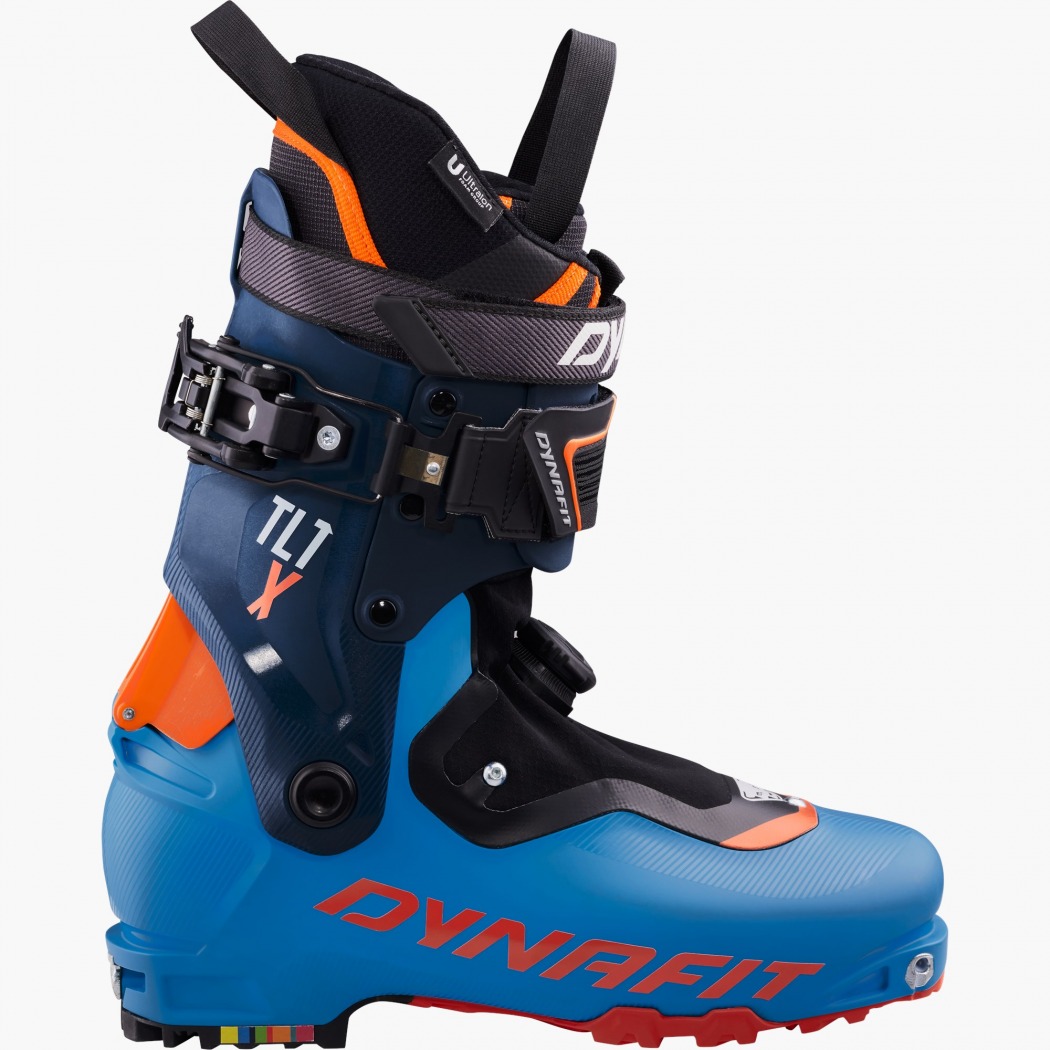
A Dynafit studio shot of the TLT X.
Dynafit is oh so close to going to XI (11). We are not there yet, nor is Dynafit. They have, though, released some sizes of the new Dynafit TLT X, which will be out in the full-size range this fall. As the X suggests, this is another numerative iteration of the storied TLT line of boots. And yes, they skipped the TLT 9 version, and depending on the glass slipper’s fit, that story was either optimistic, as in I know this foot-binding will dissipate when I’m flying up the skintrack, or maybe, the fit all along, in whatever iteration you scored, was bliss.
Always try the boot on, if you can, before you buy. And if there is anything I’ve learned from boot reviews and the follow-up comments, it’s that we all have different feet (and even different feet on the same torso) and we come to the marketplace looking for something ideal, but that ideal remains just out of reach for many.
For me, the TLT 5s were torture. The TLT 6-P was a smidge less torturous with some punching, the PDG is a slipper fit. But I was scared away many years ago from any TLT prefixed boot. Call the TLT X boot, for me, a reason to reconsider, and maybe covet, Dynafit’s latest lightweight tourers.
The Dynafit TLT X incorporates a BOA-like “Twistfit” knob that replaces the lower buckle system of the TLT 8s. The 8’s upper and lower buckles were ratcheted. And, rejoice or sigh, the new TLTs forgo the revolution that was the speed nose.
Onward.
Well, maybe not too fast. For those who want a solid synopsis of the TLT since the TLT 5, you can find a history lesson in this piece (thank you, Manasseh).
Ok, now Onward.
Fit:
Dynafit’s literature states the TLT X build is for a North American foot. Reading between the lines might mean we North Americans like some room to breathe. Dynafit calls the last width 101mm. I’m in size 27.0/27.5 (297mm BSL), and I’ll confirm this; there’s some room. Like the toebox in the new Salomon S-Lab MTN Summit, the TLT X forefoot has room enough for the toes to splay out, which is a nice sensation while skinning. And as the foot swells on longer days, it pays dividends. The longest I’ve used the boot is on a local volcano that’s roughy 5k’ up and 12 miles roundtrip. Call them comfy. Even very comfy. No rubbing, no hot spots.
The heel pocket, for me, is a bit too roomy. After the first use, I knew I needed a fix. Even when cinching down the Twistfit, which I’ve seen some outlets claim is wired around the heel to snug it down, I had undesirable heel lift. Unless I am missing something, the Twistfit wire does not route around or near the heel.
I had an inelegant solution for the heel lift that works great. I wear a pair of EZ Fit 2mm thick neoprene ankle booties. I originally bought these to help prevent blisters when breaking in new boots or liners. They also assist with improving a boot’s heel fit on occasion. Anyhow, that’s the case with me and the Dynafit TLT X. With the ankle bootie, the heel fit is solid both when touring and skiing. I’m using a lighter-weight knee-high sock from Patagonia. I can also use a heavier-weight sock without experiencing any sock bunching or undue tightness.
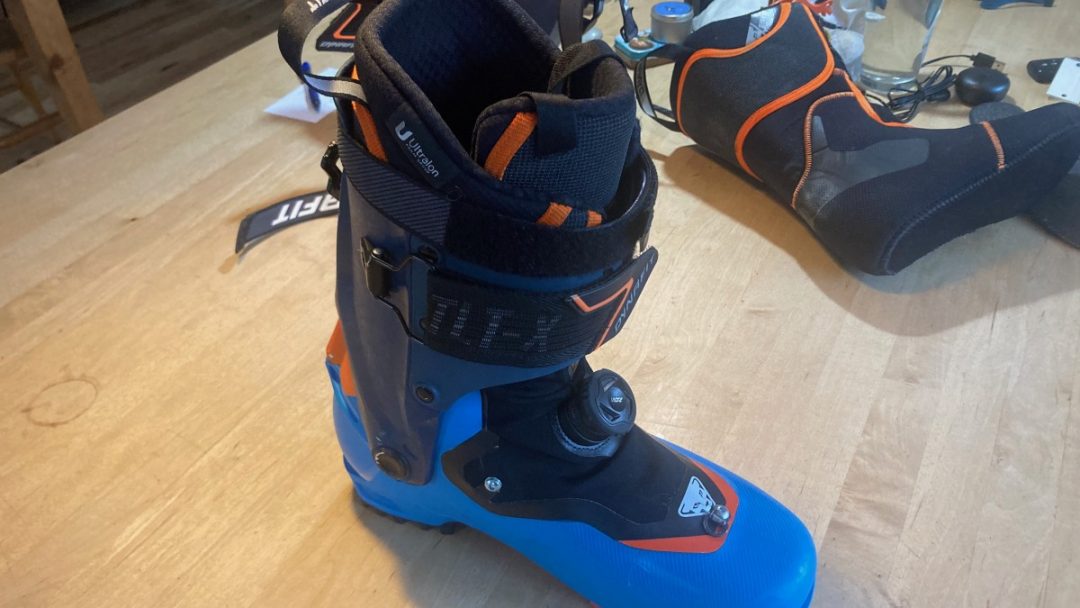
A look at the Dynafit TLT X with its Twistfit closure.

A closeup of the Twistfit knob on the boot’s lower.
I like BOA’s, that’s clear. But really, I like what works, so if a z-buckle serves the purpose of properly securing the lower boot, that’s good too. The Twistfit is nothing new; Twistfit tech has been field tested already on Dynafit DNA and Mezzalama boots, which are both in the race line, and it works. Turn the dial, and the wire tensions which secures a molded plastic piece onto the liner and thus helps lock the foot down. I can tighten the Twistfit enough to be firmly in this boot when I want to drive my ski. There’s a snug fit with the heel, side of the foot, and top of the foot. My toes can still wiggle. I’m not feeling any pressure points with the Twistfit highly tensioned, but this might be a data point you’ll likely want to test for yourself.
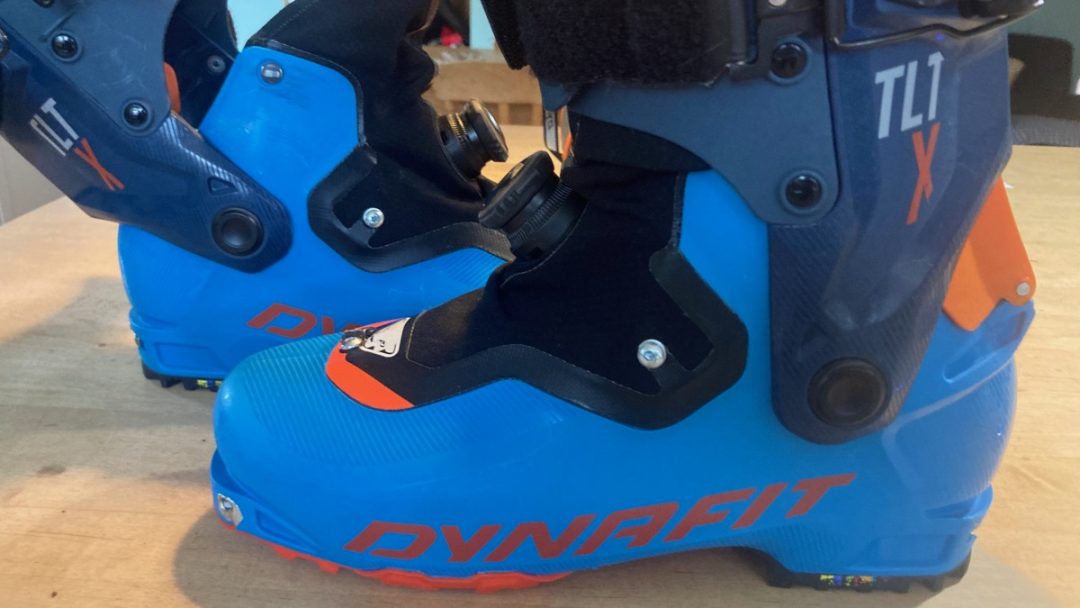
Side view of the Twistfit showing location near the midfoot/ankle interface.

Using some headlamp power to illuminate the boot guts. The wire is attached to a molded plastic plate. It’s part of the Twistfit closure system.
One thing to keep in mind, and I have dug around a bit, the Twistfit does not appear to be easily replaced in the field. That’s the case with some boots incorporating the BOA too. The Fischer’s Travers boot line does have easily fixed/replaced BOA systems. The positioning of the Twistfit knob on the TLT X does not interfere with cramponing on firm or softish snow.
I have replaced the very minimal footbeds with blue Superfeet insoles. These are the most minimal of the stock footbeds I’ve handled this season. Very little support for me. I also needed to eat some volume up; the Superfeet did that job. Otherwise, I’ve not heat molded the liner or modified the boot.
I’ve got a skinny calf. And although I have not pulled the trigger this season on modifying the cuff area of the Fischer Transalp Pros I’m in or the Salomon S-Lab MTN Summits, I’ll likely, but still undecided, add a small amount of foam to eat up some calf volume. That’s not the case with the fit of the TLT X. I do not need to hyper-tighten the upper to snug up around my calves. (Maybe North Americans have skinnier calves? My lineage certainly does, but that’s Eastern Euro.)
Transitions:
The upper cuff locks down with a single throw buckle adjusted with a velcro 45mm wide cuff strap. I’ll take ample photos to describe the mechanism. They call this, again it’s numerative, the Ultra Lock 5.0. The old version is the Ultra Lock 4.0. This is a top buckle that engages the ski / walk mechanism. And it’s Dynafit all the way. The 45mm velcro strap links with a metal clip that secures solidly to the buckle throw; adjust the velcro to your liking and throw the buckle closed. Throwing the buckle closed locks a metal wedge into the lean lock opening cut into the rear of the upper cuff and the orange spine connected to the lower boot. It is a simple system, and Dynafit has been utilizing Ultra Lock systems for several generations of boots.
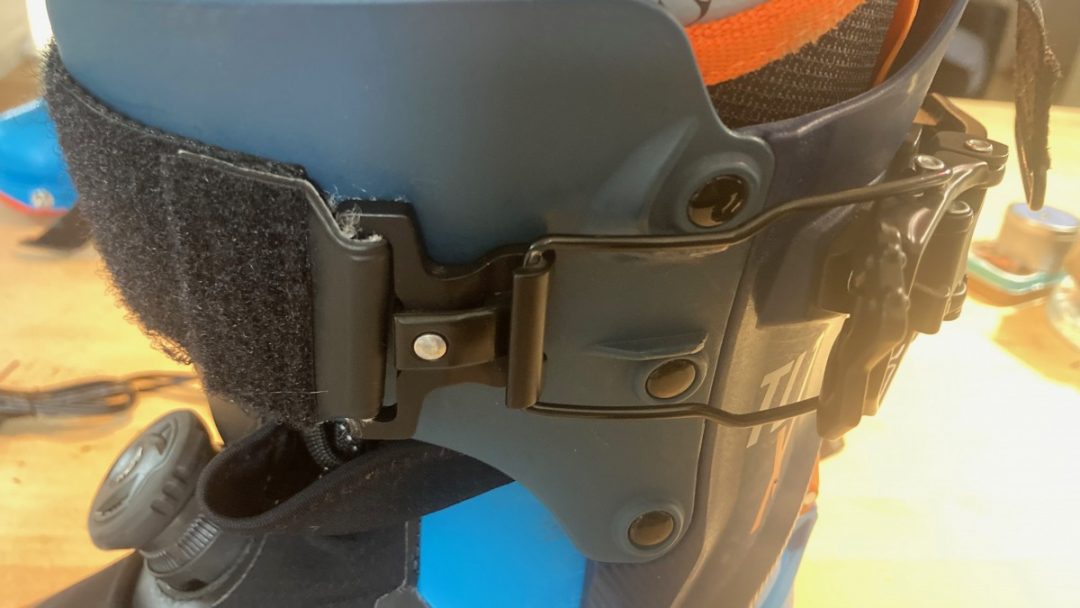
Here the buckle throw is open, which releases and open the Quick Lock 5.0 system. This means is goes from ski to walk mode.
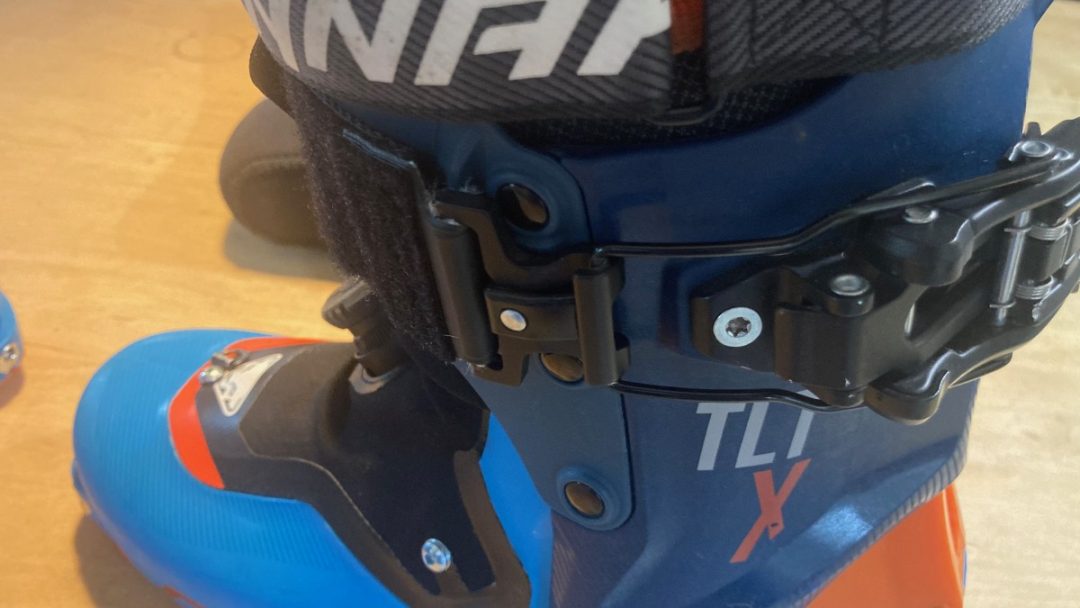
Buckle throw in the closed position. Also, this close up shows the clip, or connection point between the cuff strap and the buckle. For easy removal of the boot at the end of the tour, unclip the strap/buckle interface, loosen, and slide the boot off.

A shot of the Ultra Lock 5.0 in locked, ready to ski mode.
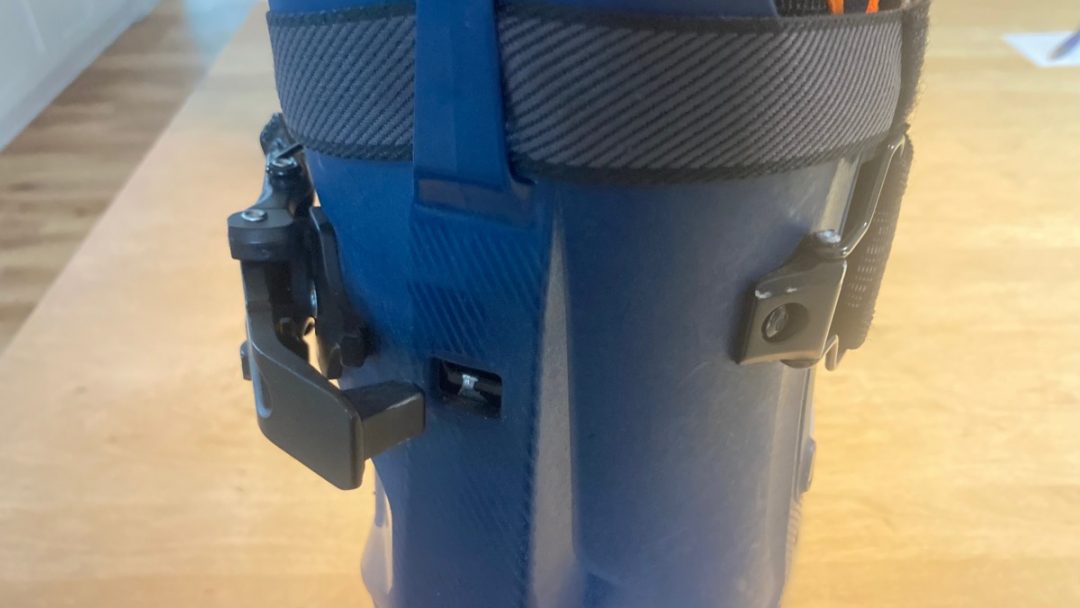
The Ultra Lock 5.0 system in walk mode.
When transitioning to touring, reverse course; throw the buckle open, and the main velcro cuff strap loosens.
I’ll state it here. I do not need to adjust the main velcro cuff strap to take advantage of the boot’s generous range of motion when transitioning, which Dynafit claims to be 60 degrees. I do, however, loosen the Twistfit when transitioning to touring. And I know it’s a particular group here. Dynafit knows this too. A smaller thinner upper power strap is optional. It’s easy to install, and I like it. I crank it down, which, for me, seems to affect forward stiffness when skiing. I do need to loosen this upper strap when transitioning to skinning. It takes me about 10 seconds per strap.
Touring:
These are kind on the uphills. The Dynafit TLT X is relatively minimal in weight and has a pivot at the ankle that feels frictionless. Other boots claim a larger range of motion (ROM), Travers Carbons (80 degrees), S-Lab MTN Summit (75 degrees), Tecnica Zero G Peak (75 degrees), and Scarpa F1LT (72 degrees). At 60m degrees for the TLT X, I’m not noticing any deficiencies in ROM. If 60 degrees is the new 70 degrees or 75 for that matter, then so be it. I have a tough time discerning the ROM difference between the S-Lab MTN Summits and TLT Xs.
I have noticed more ROM when leaning back in the boot than forward when skinning on the flats, not on the uphills. This may also have something to do with my skinning style. I tend to stay over what is referred to as the “wax pocket” on cross country skis. All this means is that when I skin on the flats, my lower body is aligned ankle-knee-hip (with some ankle flexion) and centered over (ideally) my foot, just as it would be when classic skiing. I do not open my ankle and slide the boot forward (ankle flexion greater than 90-degrees). You use more of the rearward ROM by sliding the boot forward when the ankle is past alignment with the knee. If your skinning style differs from mine, which is fine, you’ll likely take greater advantage of the rearward ROM.
The forward ROM is good, maybe not best in class, but right in there for calling this a great touring boot.
Flex:
I loved the Salomon’s S-Lab MTN Summits … and their stiffness. And their tourabilty. I took them on a three-day stint on Oregon’s Steen Mountain (a 40-mile long block fault mountain) back in early April. We bushwhacked and skinned a ton to access some fine-looking terrain. But turns were not part of the payoff. (That’s a different story.) Anyhow, I was still in Salomon mode, so I handed off the Dynafit TLT Xs to my friend Kevin Grove, a Dynafit ski boot junkie. Kevin’s thoughts on how the TLT Xs compare to his TLT lineup is forthcoming on Monday. But after a week or two of use, they were back on my doorstep. It turns out he’s still dialing in his TLT 8 Carbonios. The Carbonio’s carbon-fiber cuff and, according to one review, 120 flex rating makes it stiffer than the TLT X. Kevin, as you’ll read on Monday, wanted something more rigid.
(Dynafit will be releasing a similar boot to the TLT X, the Dynafit Blacklight, which will be nearly identical except that it comes with a carbon cuff, a Grilamind mixed with carbon for the lower and is reportedly 40g lighter.)
In all their royal blue and orange glory, the TLT Xs landed on my doorstep. Knowing Kevin and his ski style, which is not bashful, I expected a mushy boot. That was not the case. But, I do not own boots with a carbon cuff, my PDGs, a recreational race boot, post up with a fiberglass cuff. That’s about as high-tech composite as I have in an upper.
Dynafit does not provide an official flex rating for this 1kg class boot. The lower shell is Grilamid, while the cuff is a fiberglass reinforced Grilamid. The shell is modifiable with heat if you need fit mods. Locked in, this is truly a progressive flex boot. You are not bumping into a brick wall and pushing through it. They are, in my experience, stiffer than my older Fischer Travers Carbons, and decidedly softer than the 2022-2023 S-Lab MTN Summits.
Coming from the Salomon’s, I was not ready for too soft. Luckily, that’s not the sensation I’ve had with the TLT X. If you can fit the boot properly and snug down both velcro straps, the forward lean pushing into a turn can be described as graduated suppleness, but by no means are the TLT Xs too soft for my tastes. I’m so used to the Travers Carbons that I was reminded that the plastic is likely aged out in that boot. Driving the Black Crow Mentis the other day with the TLT X, I felt connected to those ski’s dynamics. By graduated suppleness, I mean you feel your shin engage, the ankle flex slightly, and the ski respond accordingly. (Yes, that’s still a killer ski.) As you push through the turn, the boot stays with you; the initial softish engagement becomes stiffer—which reflects the progressive nature of the TLT X’s flex pattern. Despite being softer than the S-Lab MTN Summits, the TLT Xs were responsive, fun, and not a liability in the variety of skiing I’ve been doing in April and now May.
Just yesterday, I found the TLT Xs driving the Blizzard Zero G 95 skis on very firm snow, which is the skis’ preferred habitat. Making tight turns through trees in what became a smiley and flowy run, I felt connected and precise with the boot-binding-ski interface.
I might use the S-Lab MTN Summits with a larger, wider ski; I’d likely remain in the 95mm or under sweet spot using the TLT X. Kevin skied the TLT X with a Dynastar M-Tour 99 (99mm) in a 178cm length. That’s a bigger, slightly heavier ski than 171cm Zero G 95s I’m on.
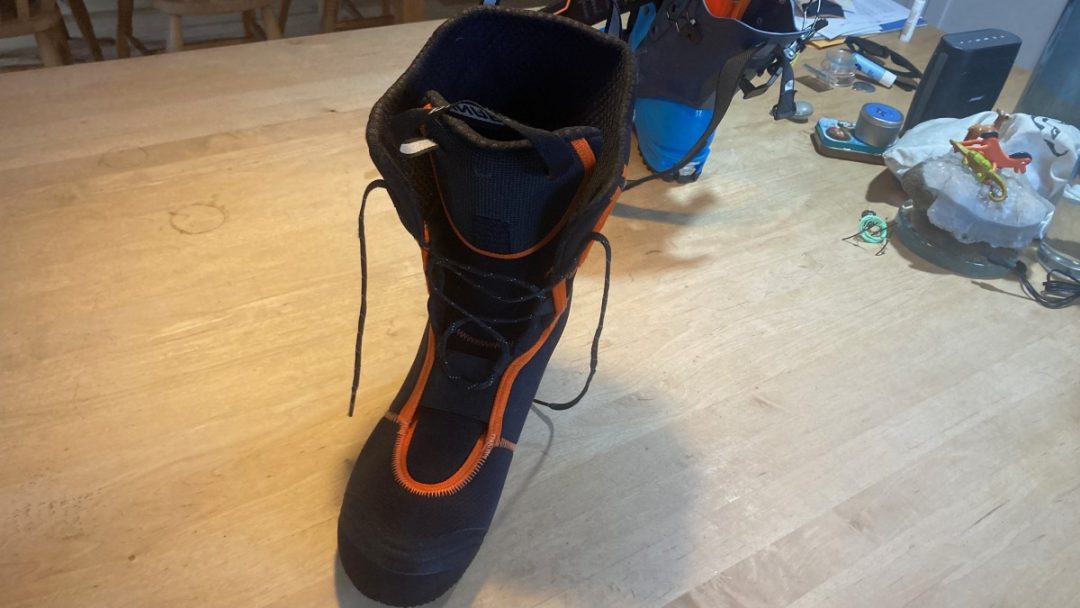
The TLT X liner is constructed using several densities of Ultralon foam.

The liner’s upper features firmer/stiffer denser foam.
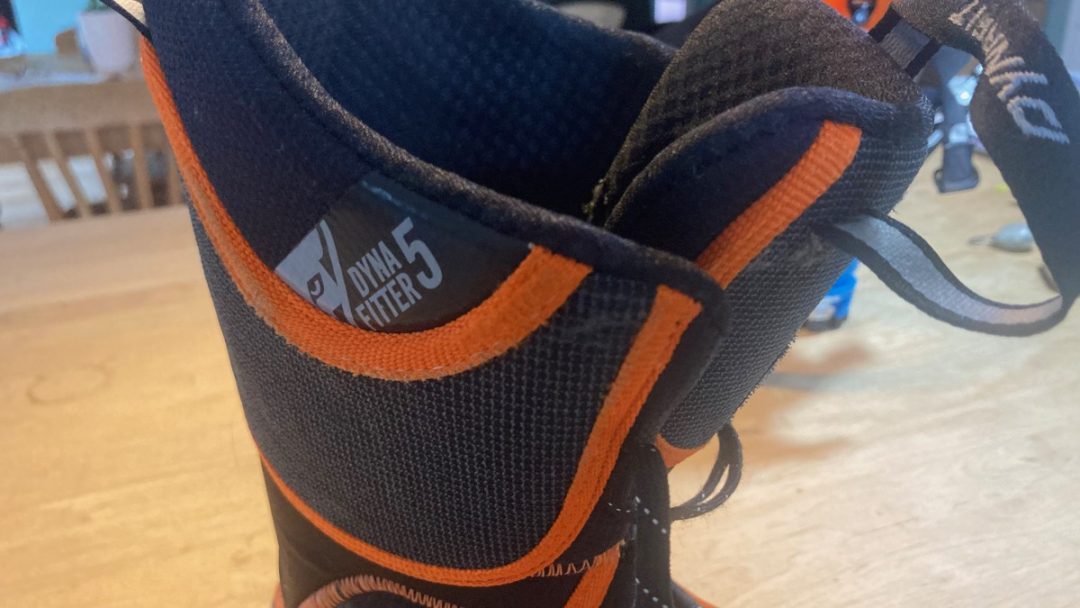
A close up of the liner’s upper and the firmer more dense foam incorporated into the upper—this helps with support/stiffness.

The liner has coatings on high wear areas.
Liner:
The Dynafit TLT X comes stock with a liner coined the Dynafitter 5. It is a lace-up and sports reinforced high wear areas on the ankles and heel. The upper’s foam is stiff, helping with some of the boot’s performance assets. The liner’s foam is from Ultralon, which looks to still be manufactured in New Zealand. The liner, to me, sits in the middle zone between a thin race liner and a full-bodied freeski liner. This is a lightish touring liner that seems to be warm, although it is not mid-winter here.
A seam on the tongue allows for good articulation when leaning forward. The tongue’s upper features thicker/stiffer foam. That same foam density encircles the liner’s upper cuff.
Other Notes
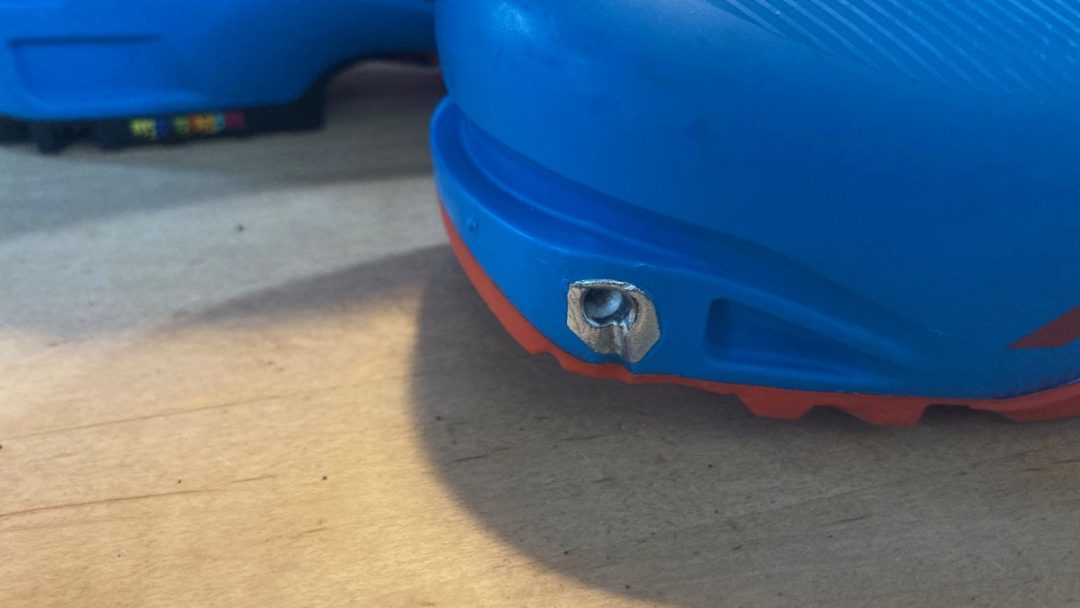
The toe welt is large enough to accommodate most automatic crampons.
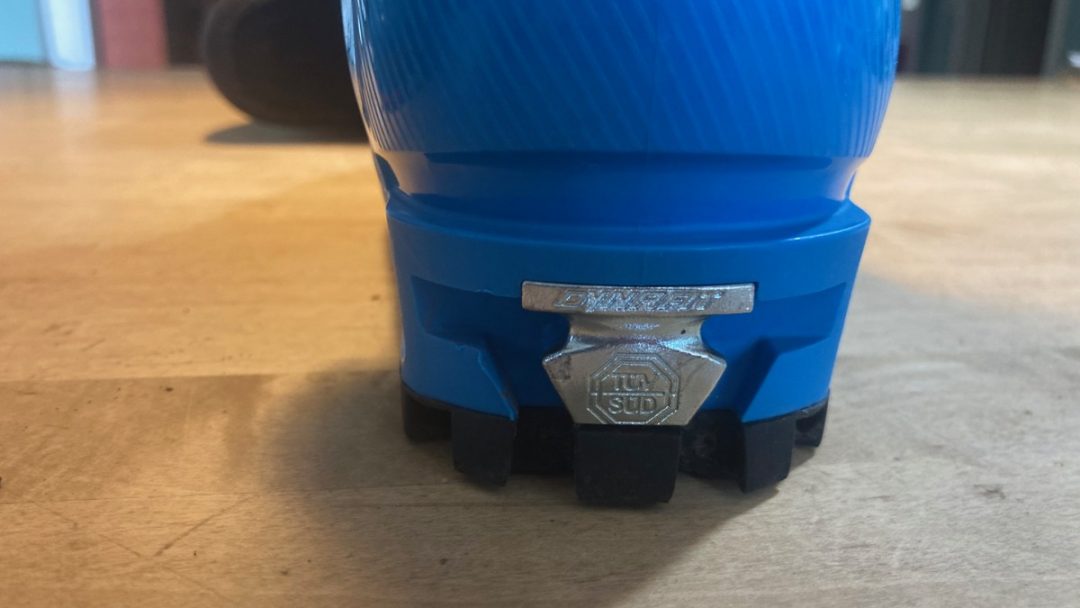
Heel fitting uses an internal bolt to fasten.
Crampon Compatibility: Toe and heel welts large enough to accommodate automatic crampons. They work great with the Blue Ice Harfangs and the Camp Nanotechs. No more speed nose for fans of front-end bluntness.
Forward Lean: 15 degrees or 18 degrees. This lean is adjustable with the flip of a metal piece (need a Torx) integrated into the orange spoiler. The boot came stock set at 15 degrees, which in this boot is to my liking.
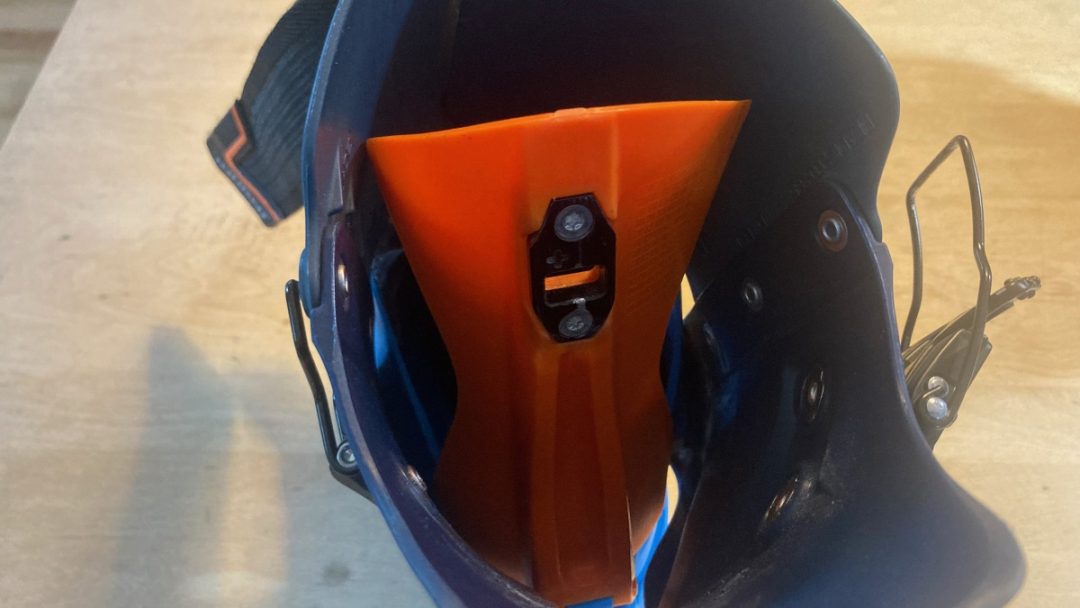
The orange spine pivots and houses the metal fitting/insert point for the Quick Lock 5.0 system. Flip the metal piece and adjust the forward lean from 15 to 18 degrees.
In closing, I also love that Dynafit is standing behind their goods. The boot comes with a “lifetime” guarantee of five years. Is it a lifetime? Not of the user. But for a boot you’ll likely bash about, at least we hope that’s the case, that sounds like a reasonable life and a reasonable lifespan for an everyday tourer. This boot, to me, is all about combining the up and the down and lots of the up and down. I’d steer clear if you insist on driving bigger skis or you are simply strong enough to accrue huge vert, haul a big / heavy ski, and makes those lovely turns.

A clean shot of the TLT X from Dynafit. The upper buckle is thrown open, the boot is in walk mode.
Stats for Size 27/27.5
Price: $799.95
Boot + Liner Weight: 1118g with the upper power strap and stock footbeds.
Liner Weight: 220g with stock footbed.
Skis I’ve Used: 2022/2023 Blizzard Zero G 95 (171cm, 95mm) with Plum 170 bindings, and Black Crows Mentis (178cm, 80mm) with BD Helio 200 LT bindings.
Cuff: Grilamid with fiberglass
Lower Shell: Grilamid
Spoiler (Orange spine connected to the lower shell): Grilamid
Sole: Pomoca
The TLT X has been released in a women’s version too.
Jason Albert comes to WildSnow from Bend, Oregon. After growing up on the East Coast, he migrated from Montana to Colorado and settled in Oregon. Simple pleasures are quiet and long days touring. His gray hair might stem from his first Grand Traverse in 2000 when rented leather boots and 210cm skis were not the speed weapons he had hoped for. Jason survived the transition from free-heel kool-aid drinker to faster and lighter (think AT), and safer, are better.
